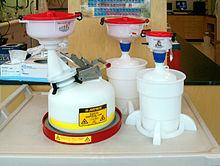Material flow management
Material flow management began as a largely academic discourse, eventually becoming an actual tool implemented by both countries and industries.
While lacking in detail, the analysis of material flow management continued to develop years later, with Robert Socolow and Valerie Thomas beginning to support findings with data, publishing their work in the Journal of Industrial Ecology in 1997.
[1] Material flow management assessment began to take country- and government-focused approaches following a 1997 publication by the World Resources Institute for the Netherlands and Germany.
[8] Another assessment was conducted by Taylor Searcy in 2017, revitalizing Fiji’s sustainable sea transportation industry to improve socio-economic and environmental impacts.
[9] The United States began seriously incorporating material flow management in its environmental policies with the Resource Conservation and Recovery Act of 1976.
Applications of the circular economy in the European Union have produced evidence of practicality, estimating that implementation in agricultural, chemical, and construction sectors could reduce up to 7.5 billion tonnes of CO2e globally.
[13] In today's studies on the effectiveness of MFM for improving productivity, an analysis of its implementation has been debated with its correlation to government roles in environmental management.
With the large spike in environmental disaster concepts regarding the depletion of resources by human activity, MFM could be interpreted as a promoter of the circular economy and an analysis of the necessity of such.
However, its critics still find these two terms – MFM and sustainability – to be at a crossroads despite the vertical integration model of manufacturing showing agreement in their processes.


